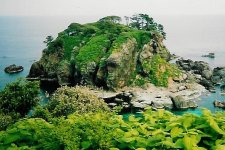Charles Harper
Régisseur
Tobishima, Japan
Tobishima, 'Jumping Island', off the Japan Sea coast of northern Honshu, is one of a loose line of offshore islands from Kyushu to Hokkaido which are of particular interest to Japanese birders. They are vagrant traps: in the spring and fall, when mainland migrants stray from the coasts of Korea, China or Russia, these islands are their first landfall. They vary in size from Sado (860 sq. km.) to Hegurajima (1 sq. km.),and are all reachable by ferry in from one to three hours, incidentally offering an opportunity for some pelagic birding, though this is not as exciting as off the open Pacific coast.
Sakata, the departure port for Tobishima, is an hour's flight and 15,000 yen from Tokyo; it is a small city, and the ferry dock is just half an hour from the airport. The ferry trip lasts 90 minutes and costs 2000 yen, 900 yen more if you want to sit on the second deck, which you do: you cannot get to the bow, but with a fellow birder and no other wealthy passengers (the local birders huddle below amidships with the smokers, and peer over the gunwales), you can work both sides of the boat very nicely. In early May you may still get many of the loons, shearwaters and alcids of this part of the world, and the endemic target, Japanese Murrelet is usually seen. The ferry is not big, and if the weather is rough, those prone to mal de mer should take precautions.
Tobishima, a little over 8 sq. km. in area, consists of a small fishing village of perhaps 100 residents, with a diesel power plant and a couple of small inns (but no shop of any kind) lining the harbour; the central island ridge above the village, along which a 3-km. paved road extends, bordered by truck gardens; and the relatively-undisturbed rest of the island, with foot trails among mature black pine and deciduous forest featuring some outstandingly beautiful pines, maples and oaks. Two rock islets are breeding grounds for Black-tailed Gulls.
Nagoshi Inn, a few steps from the ferry landing, is very modest by Japanese standards, but it is clean and pleasant, has a nice hot bath and, thank God, western-style toilets. It costs 8000 yen a night with breakfast and dinner, both delicious for those who love seafood. They will make little rice-ball lunches to carry with you in the morning. Inn reservations should be made well ahead, and far, far ahead during spring and fall national holidays. Nagoshi Inn can be reached (no English spoken) at 0234-95-2004. Drop the initial zero when calling from overseas.
The task of the birder is simply to spend the day-- in late April to early May from about 4:30 in the morning to 5:30 in the evening-- wandering casually back and forth along the trunk road and trails looking for the one or two individuals of any of the 200 species that have been recorded on this tiny island and that may be there at the moment.
There is a tiny dam, collecting rainwater in a tiny ravine, just above Nagoshi Inn, and this is a good starting point at dawn, where a Japanese Night Heron may have spent the night, or a Mugimaki Flycatcher has come down to bathe. Then, following the steps on up to the ridge, you meet the sun and one or two fishermen's wives, who have come up to tend their gardens. There seem to be no young people on the island-- they have all gone off to seek fame and fortune in Tokyo-- only gnarled old men, who have already set off in their boats in the dark before dawn, and their bent, bonneted wives, who either nod a slight greeting or ignore you. In May the new shoots are up and the gardens netted over and festooned with scarecrows. One patch sports a dead, gibbeted Whiskered Auklet, hung as a warning to other Whiskered Auklets who might be tempted to raid the young potato plants. This area you scour carefully for bunting and pipits: some 30 species have been found here.
Passing out of this cultivated area, the mixed woodland can be searched for cuckoos (4 sp.), thrushes (17 sp.), warblers, (12 sp.) and flycatchers (10 sp.). Endemics and near-endemics like Japanese Woodpigeon, Japanese Waxwing, Japanese Accentor, Latham's Snipe, Japanese Yellow Bunting, Red-cheeked Starling, Japanese Robin, Grey Bunting all appear here commonly in migration, but Japanese birders are looking for Hoopoe, Wryneck, Blythe’s Pipit, Swinhoe's Robin, Siberian Rubythroat, Black-throated Thrush, Radde's Warbler.
Returning to the village in the late afternoon, you can look for a short-toed lark or a Japanese Wagtail in the waste lots dockside, study Temminck’s Cormorants along the breakwater, watch the locals spreading seaweed or filleted fish out to dry on bamboo mats, or spend 30 seconds exploring a Yayoi period burial crevice, the island’s lone cultural attraction. If you're just plain tired, go soak in the bath, order two bottles of Kirin with dinner, and go to bed early. There's nothing to do after dark except listen to the Brown Hawk Owls quietly hoo-hooing from the trees.
All in all, a laid-back birding experience. We got 86 species in 2½ days, May 10-12, 2003 (list appended).
SPECIES
Temminck's (Japanese) Cormorant
Pelagic Cormorant
Great Cormorant
Mallard
Spot-billed (Grey) Duck
Common Teal
Eurasian Wigeon
Japanese Murrelet
Rhinoceros Auklet
Streaked Shearwater
Pomerine Jaeger
Herring (Vega) Gull
Slaty-backed Gull
Black-tailed Gull
Glaucous-winged Gull
Glaucous Gull
Common Tern
Black-crowned Night Heron
Intermediate Egret
Grey Heron
Great Egret
Common Sandpiper
Latham's (Japanese) Snipe
Northern (Red-necked) Phalarope
Black Kite
Northern Sparrowhawk
Peregrine Falcon
Brown Hawk Owl
Japanese Wood Pigeon
Rufous (Oriental) Turtle Dove
Rock Dove
Oriental Cuckoo
Northern White-rumped (Fork-tailed) Swift
Greater Short-toed Lark
Barn Swallow
Red-rumped Swallow
Grey Wagtail
Black-backed Wagtail
Japanese Wagtail
Red-throated Pipit
Indian Tree (Olive-backed) Pipit
Ashy Minivet
Brown-eared Bulbul
Bull-headed Shrike
Japanese Waxwing
Bohemian Waxwing
Siberian Blue Robin
Red-flanked Bluetail
Daurian Redstart
Common Stonechat
Blue Rock Thrush
Siberian Thrush
White's Ground Thrush
Brown Thrush
Grey-headed (Eye-browed) Thrush
Grey-backed Thrush
Pale Thrush
Dusky Thrush
Japanese Bush Warbler
Arctic Warbler
Eastern Crowned (Willow) Warbler
Narcissus Flycatcher
Mugimaki Flycatcher
Tricolor (Korean) Flycatcher
Blue-and-White Flycatcher
Asian Brown Flycatcher
Grey-spotted Flycatcher
Coal Tit
Great Tit
Japanese White-eye
Siberian Meadow Bunting
Rustic Bunting
Black-faced Bunting
Japanese Yellow Bunting
Grey Bunting
Oriental Greenfinch
Siskin
Brambling
Japanese Grosbeak
Hawfinch
Cinnamon (Russet) Sparrow
Eurasian Tree Sparrow
Red-cheeked Starling
Grey (White-cheeked) Starling
Rook
Carrion Crow
Jungle Crow
FOR 2004 TRIP RESULTS, SEE LATER POSTING IN THIS THREAD.
Tobishima, 'Jumping Island', off the Japan Sea coast of northern Honshu, is one of a loose line of offshore islands from Kyushu to Hokkaido which are of particular interest to Japanese birders. They are vagrant traps: in the spring and fall, when mainland migrants stray from the coasts of Korea, China or Russia, these islands are their first landfall. They vary in size from Sado (860 sq. km.) to Hegurajima (1 sq. km.),and are all reachable by ferry in from one to three hours, incidentally offering an opportunity for some pelagic birding, though this is not as exciting as off the open Pacific coast.
Sakata, the departure port for Tobishima, is an hour's flight and 15,000 yen from Tokyo; it is a small city, and the ferry dock is just half an hour from the airport. The ferry trip lasts 90 minutes and costs 2000 yen, 900 yen more if you want to sit on the second deck, which you do: you cannot get to the bow, but with a fellow birder and no other wealthy passengers (the local birders huddle below amidships with the smokers, and peer over the gunwales), you can work both sides of the boat very nicely. In early May you may still get many of the loons, shearwaters and alcids of this part of the world, and the endemic target, Japanese Murrelet is usually seen. The ferry is not big, and if the weather is rough, those prone to mal de mer should take precautions.
Tobishima, a little over 8 sq. km. in area, consists of a small fishing village of perhaps 100 residents, with a diesel power plant and a couple of small inns (but no shop of any kind) lining the harbour; the central island ridge above the village, along which a 3-km. paved road extends, bordered by truck gardens; and the relatively-undisturbed rest of the island, with foot trails among mature black pine and deciduous forest featuring some outstandingly beautiful pines, maples and oaks. Two rock islets are breeding grounds for Black-tailed Gulls.
Nagoshi Inn, a few steps from the ferry landing, is very modest by Japanese standards, but it is clean and pleasant, has a nice hot bath and, thank God, western-style toilets. It costs 8000 yen a night with breakfast and dinner, both delicious for those who love seafood. They will make little rice-ball lunches to carry with you in the morning. Inn reservations should be made well ahead, and far, far ahead during spring and fall national holidays. Nagoshi Inn can be reached (no English spoken) at 0234-95-2004. Drop the initial zero when calling from overseas.
The task of the birder is simply to spend the day-- in late April to early May from about 4:30 in the morning to 5:30 in the evening-- wandering casually back and forth along the trunk road and trails looking for the one or two individuals of any of the 200 species that have been recorded on this tiny island and that may be there at the moment.
There is a tiny dam, collecting rainwater in a tiny ravine, just above Nagoshi Inn, and this is a good starting point at dawn, where a Japanese Night Heron may have spent the night, or a Mugimaki Flycatcher has come down to bathe. Then, following the steps on up to the ridge, you meet the sun and one or two fishermen's wives, who have come up to tend their gardens. There seem to be no young people on the island-- they have all gone off to seek fame and fortune in Tokyo-- only gnarled old men, who have already set off in their boats in the dark before dawn, and their bent, bonneted wives, who either nod a slight greeting or ignore you. In May the new shoots are up and the gardens netted over and festooned with scarecrows. One patch sports a dead, gibbeted Whiskered Auklet, hung as a warning to other Whiskered Auklets who might be tempted to raid the young potato plants. This area you scour carefully for bunting and pipits: some 30 species have been found here.
Passing out of this cultivated area, the mixed woodland can be searched for cuckoos (4 sp.), thrushes (17 sp.), warblers, (12 sp.) and flycatchers (10 sp.). Endemics and near-endemics like Japanese Woodpigeon, Japanese Waxwing, Japanese Accentor, Latham's Snipe, Japanese Yellow Bunting, Red-cheeked Starling, Japanese Robin, Grey Bunting all appear here commonly in migration, but Japanese birders are looking for Hoopoe, Wryneck, Blythe’s Pipit, Swinhoe's Robin, Siberian Rubythroat, Black-throated Thrush, Radde's Warbler.
Returning to the village in the late afternoon, you can look for a short-toed lark or a Japanese Wagtail in the waste lots dockside, study Temminck’s Cormorants along the breakwater, watch the locals spreading seaweed or filleted fish out to dry on bamboo mats, or spend 30 seconds exploring a Yayoi period burial crevice, the island’s lone cultural attraction. If you're just plain tired, go soak in the bath, order two bottles of Kirin with dinner, and go to bed early. There's nothing to do after dark except listen to the Brown Hawk Owls quietly hoo-hooing from the trees.
All in all, a laid-back birding experience. We got 86 species in 2½ days, May 10-12, 2003 (list appended).
SPECIES
Temminck's (Japanese) Cormorant
Pelagic Cormorant
Great Cormorant
Mallard
Spot-billed (Grey) Duck
Common Teal
Eurasian Wigeon
Japanese Murrelet
Rhinoceros Auklet
Streaked Shearwater
Pomerine Jaeger
Herring (Vega) Gull
Slaty-backed Gull
Black-tailed Gull
Glaucous-winged Gull
Glaucous Gull
Common Tern
Black-crowned Night Heron
Intermediate Egret
Grey Heron
Great Egret
Common Sandpiper
Latham's (Japanese) Snipe
Northern (Red-necked) Phalarope
Black Kite
Northern Sparrowhawk
Peregrine Falcon
Brown Hawk Owl
Japanese Wood Pigeon
Rufous (Oriental) Turtle Dove
Rock Dove
Oriental Cuckoo
Northern White-rumped (Fork-tailed) Swift
Greater Short-toed Lark
Barn Swallow
Red-rumped Swallow
Grey Wagtail
Black-backed Wagtail
Japanese Wagtail
Red-throated Pipit
Indian Tree (Olive-backed) Pipit
Ashy Minivet
Brown-eared Bulbul
Bull-headed Shrike
Japanese Waxwing
Bohemian Waxwing
Siberian Blue Robin
Red-flanked Bluetail
Daurian Redstart
Common Stonechat
Blue Rock Thrush
Siberian Thrush
White's Ground Thrush
Brown Thrush
Grey-headed (Eye-browed) Thrush
Grey-backed Thrush
Pale Thrush
Dusky Thrush
Japanese Bush Warbler
Arctic Warbler
Eastern Crowned (Willow) Warbler
Narcissus Flycatcher
Mugimaki Flycatcher
Tricolor (Korean) Flycatcher
Blue-and-White Flycatcher
Asian Brown Flycatcher
Grey-spotted Flycatcher
Coal Tit
Great Tit
Japanese White-eye
Siberian Meadow Bunting
Rustic Bunting
Black-faced Bunting
Japanese Yellow Bunting
Grey Bunting
Oriental Greenfinch
Siskin
Brambling
Japanese Grosbeak
Hawfinch
Cinnamon (Russet) Sparrow
Eurasian Tree Sparrow
Red-cheeked Starling
Grey (White-cheeked) Starling
Rook
Carrion Crow
Jungle Crow
FOR 2004 TRIP RESULTS, SEE LATER POSTING IN THIS THREAD.
Attachments
Last edited:







